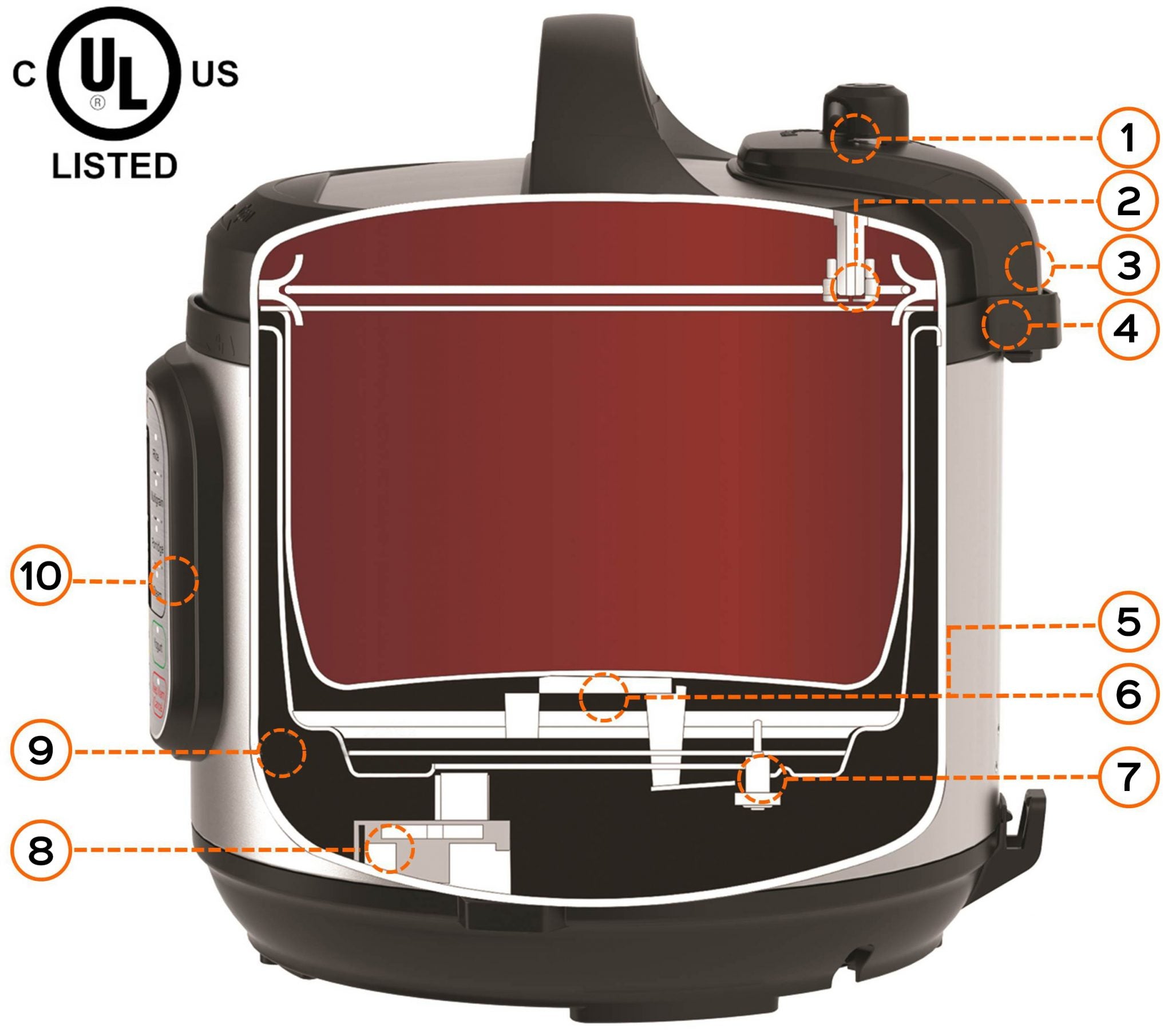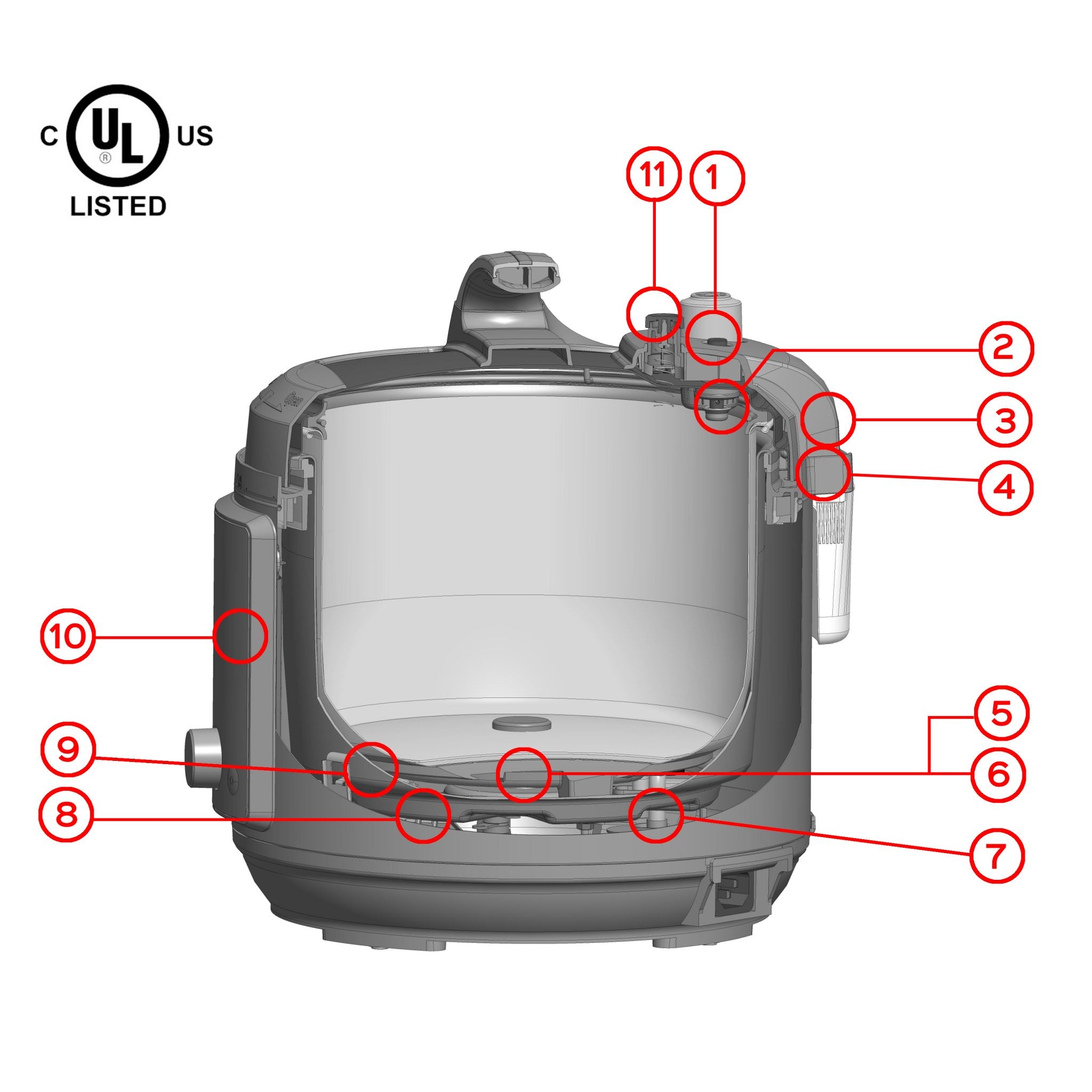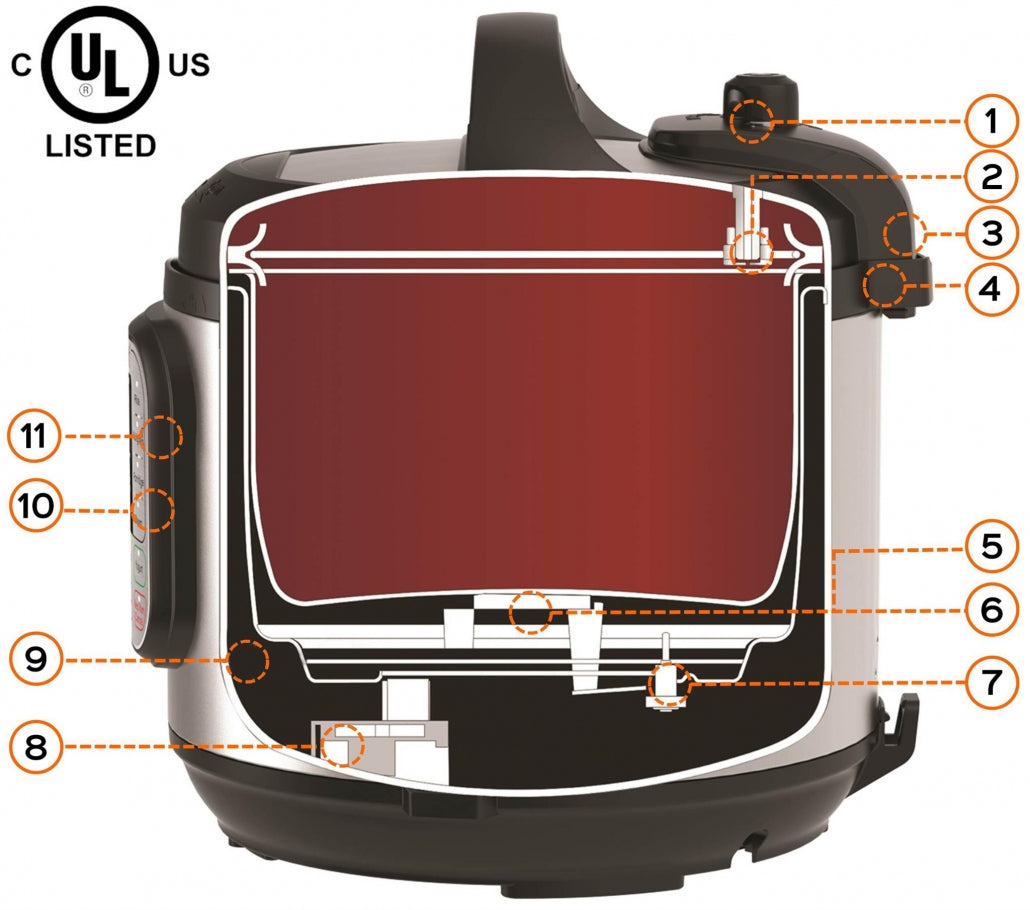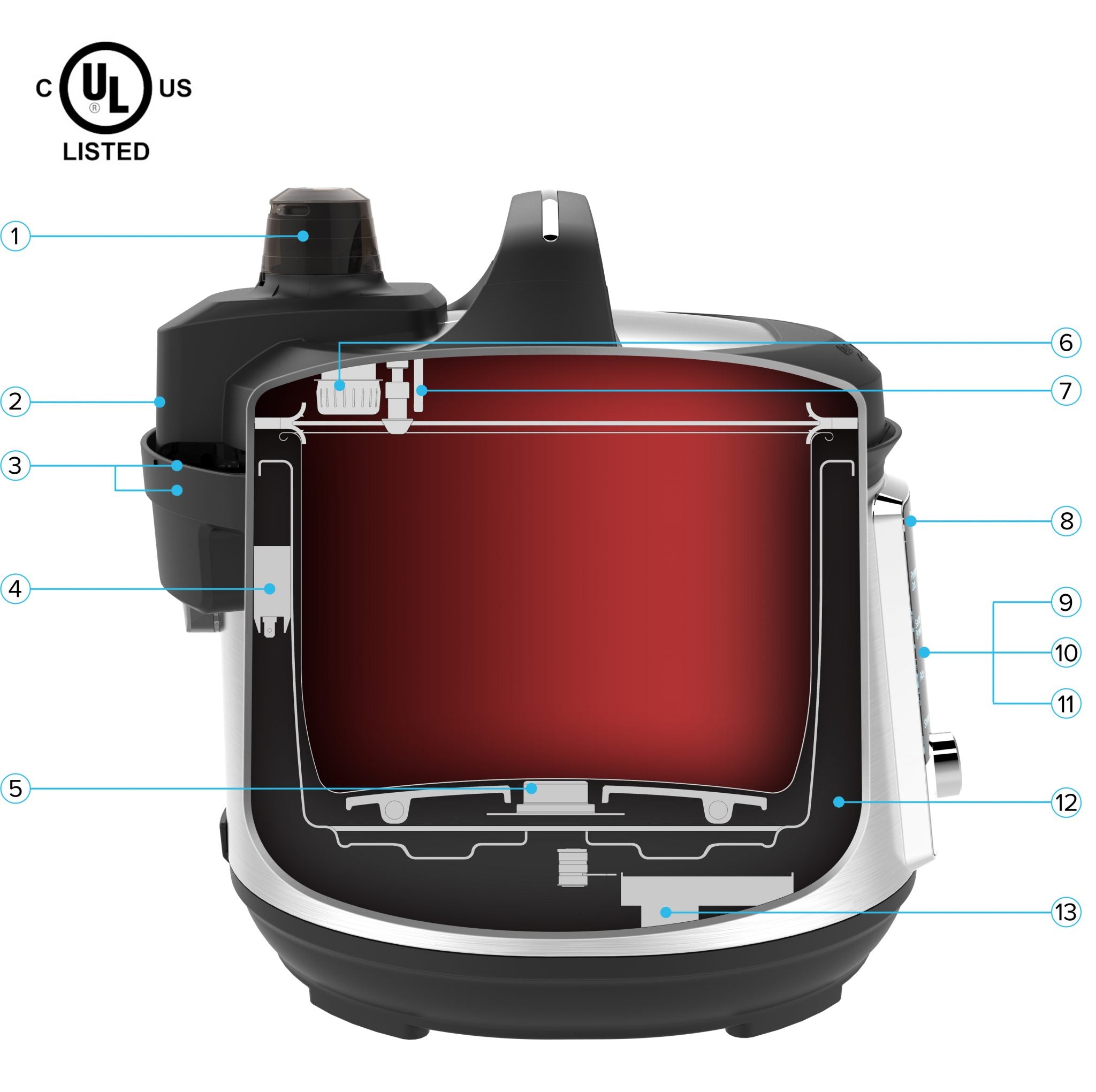
Instant Pot® Specialty Products
Instant Pot® Aura™
Instant Pot® Cuisine Crisp
Instant Pot® Duo™
Instant Pot® Duo™ Sous Vide
Instant Pot® Duo™ Evo Plus
Instant Pot® Duo Nova
Instant Pot® Duo Nova Plus
Instant Pot® Opal™ Pro
Instant Pot® Duo Gourmet
Instant Pot® Gem™
Instant Pot® Lux™
Instant Pot® Max™
Instant Pot® Rio™
Instant Pot® Smart WiFi™
Instant Pot® Smart Bluetooth®
Instant Pot® Ultra™
Instant Pot® Duo Crisp™
Instant Pot® Crisp™
Instant Pot® Air Fryer Lid
Instant Pot® Pro
Instant Pot® Pro Plus
Instant Pot® Viva™
Instant™ Cuisine 18L Cuisine Air Fryer and Toaster Oven
Instant™ Essentials™
Instant™ Vortex™ Slim
Instant™ Vortex™
Instant™ Vortex™ Plus
Instant™ Vortex™ Pro
Instant Pot® Pro - Getting Started
General Care of your Instant Pot®
Instant Pot® Duo Plus- Eggy Perfection
Instant Pot® Pro Series

Instant Pot® is designed with 10 Safety Mechanisms to eliminate many common errors which may cause harm or spoil food. The following Safety Mechanisms are applicable to: Lux 6-in-1, Duo 7-in-1, Duo Plus 9-in-1 and Smart Bluetooth.

Instant Pot® is designed with 11 Safety Mechanisms to eliminate many common errors which may cause harm or spoil food. The following Safety Mechanisms are applicable to the Ultra Series.

Instant Pot Smart WiFi is designed with 11 Safety Mechanisms to eliminate many common errors which may cause harm or spoil food.

Instant Pot Max is designed with 13 Safety Mechanisms to eliminate many common errors which may cause harm or spoil food. Max 13 Safety Mechanisms are:
The inner pot of the cooker (the stainless steel cooking pot), the sealing ring, the lid, and the steam rack are all dishwasher safe—yet another way in which your cooker makes cooking and cleanup extremely easy. Here is an overview of how best to care for and clean your Instant Pot®.
Prior to cleaning, ensure the cooker is unplugged and has cooled down.
Cooker Base and Heating Element

The cooker base is home to the microprocessor and the heating element essential to cooking.
Do Not Place in the Dishwasher! If the cooker base gets wet, allow it to dry completely. Contact the Customer Care team.
Clean the exterior of the cooker base with a damp cloth. You can use a slightly damp cloth to clean the inside of the cooker. It is however, important that the cooker be kept dry.
If you need to clean the area around the lip of the cooker, use a damp cloth or an old toothbrush to clean the edges.
Stainless Steel Inner Pot & Steam Rack

The inner pot and the steam rack are made of sturdy, food-grade stainless steel (304 – 18/8) and are entirelydishwasher safe. For the most part, you can keep the inner pot cleaned just as you would clean any stainless steelpot—by hand washing or the dishwasher.
Should the inner pot develop harmless water stains, non-abrasive scouring cleanser, made especially for cookingpots, brings back the original shine.
You can also periodically clean the inner pot by placing 1 cup of white vinegar in the bottom of the inner pot. Allow it to rest for 5 minutes, and then pour out the vinegar and rinse.
Removing Bluish Marks from Your Stainless Steel Inner Pot

Instant Pot’s inner pot (cooking pot) is stainless steel, food grade 304 (18/8) with no chemical coating. It is durable and will retain its appearance for years to come with proper care.
With stainless steel cookware it is not uncommon for a bluish or “rainbow” discoloration to appear on the inside of the pot, and Instant Pot’s inner pot is no exception. Minerals or salt in the food and water are the cause forthis discoloration. It may be easily removed by using a non-abrasive stainless steel cleaner, which will not only remove the marks it will help to retain the original brightness.
Another option is to cover the bottom with white vinegar. Allow the vinegar to sit for 5 minutes, remove, andrinse the inner pot. The discoloration marks should be removed completely.
For “White Hard Water” stains, they can be removed with a damp sponge soaked in vinegar or lemon.
We recommend avoiding steel wool, as it will scratch the surface. For additional information, verify “ eHow” or “British Stainless Steel Association”.
The images illustrate an Instant Pot® inner pot after an 8-month period of regular use and the results after using white vinegar to clean the stains.

Lid

The lid is top-rack dishwasher safe. It is best to remove the sealing ring and the anti-block shield so that the lid may be thoroughly cleaned. One way to prevent the lid from retaining odors is to place it upside down on the pot until it has completely dried or you are ready to use it. Verify the steam release valve and float valve, and make sure there is no food or other debris that would block them, and prevent your cooker from coming to pressure
Anti-block Shield

The anti-block shield underneath the lid should be removed and cleaned after each use, especially following the preparation of foods that may splatter.
To remove, using your thumb, push the side of the anti-block shield towards the lid rim and lift up. It may take a little effort, but the anti-block shield should pop out.
You can now wash the shield with warm, soapy water. Rinse, wipe dry with a soft cloth, and place back in position when dry. To position the anti-block shield in place, push down.
Sealing Ring
The sealing ring is made of high-quality, heat-resistant silicone. It can be hand-washed with soapy water or placed in the dishwasher. Allow the ring to dry completely before inserting back into the lid. Ensure the sealing ring is positioned in the lid after every wash, and that it is securely in place before you start cooking.
The sealing ring is critical in the functioning of your cooker. Inspect it carefully after it is washed. Any sign of cracking or other damage, replace the sealing ring. Replace only with Genuine Instant Pot® sealing rings, using other brands may void your Instant Pot® Warranty.
As silicone may pick-up food odors during cooking you may wish to have one sealing ring for savory and another for sweet foods.
Under normal conditions it should be fine for 18 – 24 months. If you notice cracks, leaking or deformation in the sealing ring, it should be replaced immediately. However, the sealing ring is porous and may absorb odors and become discolored. To avoid discoloration and odors, you may wish to change the sealing ring every 6 – 12months.
Condensation Collector

The condensation collector is to be removed and hand washed periodically. Allow to dry before replacing.
To Summarize
All parts of the Instant Pot® with the exception of the cooker base are dishwasher safe. This includes the stainless steel inner pot, the lid, the sealing ring, and the steam rack. The cooker base must be kept dry, and canbe wiped down with a damp cloth when necessary. The anti-block shield should be washed after each use and re-installed.
Allow to cool before cleaning, and dry thoroughly before storing.
Never clean with harsh chemical detergents, abrasive powders or scouring pads.
Removable Element Cover. Hand Wash only. Wash after each use in hot water with mild dish soap. Dry thoroughly before attaching to main body.
Main Body. Damp Wash only. Wipe body and display as needed with a soft, barely damp cloth or sponge.
Element. Damp Wash only. Wipe as needed with hot water and mild dish soap or vinegar. Dry thoroughly before replacing removable element cover.
WARNING! Do not immerse main body in water and do not attempt to cycle through dishwasher. Do not submerge power cord at any time. Do not wet prongs of detachable cord.
Clean blender, parts, and accessories after each use. Do not use harsh chemicals, scoring pads or other abrasive cleaners.
Cleaning Method Part Notes Dishwasher Safe Lid & Lid Cap
Remove lid cap from lid when cleaning.
Remove black silicone seal from lid periodically for cleaning.
150mL / 5oz Measuring CupIf dishwashing, place in top rack.Food TamperIf dishwashing, place in top rack.Strainer BagTurn inside out when cleaning, and spread open to dry.Cleaning BrushUse to clean under blades in pitcher Hand Wash Only Glass Pitcher
Do not wet bottom side of pitcher.
Ensure bottom of pitcher is dry before placing it on blender base.
Do not store food in the pitcher.
Unplug and wipe clean with a soft, damp cloth.
When in storage or not in use, do not fold the power cord.
Pulse Cleaning
Use Pulse/Clean to remove superficial food debris and residue from your pitcher.
Deep Cleaning
Minerals in water may deposit at the bottom of the pitcher. Periodic deep cleaning will ensure the longevity of the blender.
For stubborn stains, unplug the blender and add 1 cup (250mL / 8oz) of white vinegar to the pitcher, then scrub with the cleaning brush. Repeat this process as necessary.
Remove lid cap from lid when cleaning.
Remove black silicone seal from lid periodically for cleaning.
Do not wet bottom side of pitcher.
Ensure bottom of pitcher is dry before placing it on blender base.
Do not store food in the pitcher.
Unplug and wipe clean with a soft, damp cloth.
When in storage or not in use, do not fold the power cord.
You’ll only need to pair your device once, then it will remember your Instant Pot®. You may control multiple appliances from the same device.
Current App Version:
Current Firmware Version:
1.0017 (June 2019) – required for Sous Vide Instant Start function
Check below tab ‘Using the App – New Firmware Update’ (Note: your Smart WiFi needs to be left plugged in and connected for a while to receive new Firmware notification.)
Supported Operating Systems:
iPhone and iPad: iOS 10, 11, 12, 13
Android™: 5.1, 6, 7, 8, 9, 10
5-5-5 or 6-6-6: A method used to prepare eggs in your Instant Pot®. It refers to 5 minutes on high pressure, 5 minutes natural release and 5 minutes ice-bath prior to peeling.
Anti-Block Shield: The round metal part with 5 holes underneath the lid. It is designed to prevent food particles from interfering with the steam release valve. It should be removed and cleaned after each use, especially following the preparation of foods that may splatter. To remove using your thumb, push the side of the anti-block shield towards the lid rim and lift up. It may take a little effort, but the anti-block shield will pop out.
Burn: There may be insufficient water/broth in the inner pot, or food may be too close or stuck to the bottom of the inner pot with all the liquid on top.
Condensation Collector: The cup positioned at the rear of your Instant Pot®. It is used to capture any condensation that develops during cooking. Note: The Lux series does not include a condensation collector.
Cooker Base: Contains the microprocessor and the heating element. Never place anything on the inside of the cooker base without the stainless steel inner pot in position. The cooker base and lid must be kept away from external heat source, as it will damage the base and the lid.
Delay Start or Timer (older models): Sets the time delay before a cooking program starts.
Dual Pressure: The cooker includes both pressure settings low and high
EPC: Electric Pressure Cooker
Float Valve (Pin): The silver or red pin beside the steam valve, when it is up, your cooker is fully pressurized; when it drops it is no longer pressurized and you can open the cooker.
HP: High Pressure mode
LP: Low Pressure mode
Manual or Pressure Cook (newer models): Use Manual/Pressure Cook program to set custom time and/or pressure level when you pressure cook.
Natural Release (NR or NPR): Allow the cooker to cool down naturally until the float valve drops down. This may take 10 to 40 minutes, or even longer, depending on the amount of food in the cooker. After the cooking process is completed, the cooker will go into the “Keep Warm” mode if it has been turned ON.
PC: Pressure Cooker
PIP: Pot-in-Pot, refers to placing another pot inside your stainless steel inner pot to prepare a dish.
Quick Release (QR or QPR): Turn the Steam Release handle or press the Quick Release Button to the “Venting” position to let out steam until the float valve drops down. QR is not suitable for food with large liquid volume or high starch content such as: oatmeal, porridge, beans, sticky liquids, starchy soup, etc. as food content may splatter out, use Natural Release (NR) instead.
Sealing Ring: The silicone ring positioned underneath the lid. The sealing ring must be in position for the pressure cooker to come to pressure. Made of high-quality, heat-resistant silicone. The sealing ring is critical to the proper functioning of your Instant Pot®, it must always be positioned properly on the underside of the lid. Only use Genuine Instant Pot® sealing rings, other brands will void your warranty.
Sling: Used for PIP to easily remove the pot from the inner pot. Slings can be in silicone or aluminum foil.
Stainless Steel Inner Pot: The inner pot that is positioned inside the cooker base, where the food and liquid are placed. Made from food grade 304 (18/8) stainless steel, 3-ply bottom for even heat distribution, no chemical coating, compliant with FDA food safety standards. Dishwasher safe.
Steam Rack (Trivet): The steam rack is positioned inside the stainless steel inner pot. It is used to elevate food or your dish above the water in the bottom of the inner pot while you pressure cook.
Steam Release handle or Quick Release Button (Ultra): The valve that seals in or releases steam when you pressure cook. Ensure the valve is in the “Sealing” position. This is how the pressure cooker will come up to pressure. It is normal while building pressure for small amounts of steam to release through the knob. Turning the knob to “Venting” will release the pressure. The steam release handle does not lock tightly it will fit loosely on the lid.
Water Test (Initial Test Run): To help you become familiar with your Instant Pot® and to ensure the cooker is functioning properly.
PRESSURE COOK/MANUAL – This is the setting you’re likely to use the most. The temperature, pressure levels, and cooking times can be controlled through the operation keys on the control panel. Here, press the Pressure Level key to adjust the pressure level and the +/- keys to change the cooking time
SOUP/BROTH – Brings soups to a slow simmer, and results in a clear broth. For meatless soups, use the Less mode; for soups with meat, use the Normal mode; for soups that requires longer cook times, such as rich bone broth, use the More mode.
MEAT/STEW – Best for cooking large cuts of meat at high pressure. For a soft texture, use the Less mode; for a very tender meat texture, use the Normal mode; for fall-off-the bone texture, use the More mode
BEAN/CHILI – Using this program results in different doneness levels for beans. For a firmer bean texture, use the Less mode; for a softer bean texture, use the Normal mode; for a very soft bean texture, use the More mode.
CAKE – This high-pressure mode creates a very moist, dense cake. For a lighter, moister cake, use the Less mode; for a denser cake, use the Normal mode; for a really dense cake, such as a New York Style cheesecake, use the More mode
EGG – This program is designed for cooking extra-large eggs, so you may need to adjust the time for smaller eggs. For a soft-cooked egg, use the Less mode; for a medium cooked egg, use the Normal mode; for a hard-cooked egg, use the More mode
SAUTÉ – Yes, you can sauté food in your Instant Pot® just as you would in a pan.
Use Less mode for simmering, thickening, reducing liquids and for foods that may burn easily; use Normal mode for searing; use More mode for browning and stir-frying. Remember, the maximum time for sauté is in 30 minute intervals as a safety precaution
SLOW COOK – Use the Less to correspond to a low (8 hour) slow cooker setting; use the Normal mode to correspond to a medium (6 hour) slow cooker setting; use the More mode to correspond to a high (4 hour) slow cooker setting
RICE – This program cooks on low pressure, and is best used for white rice. For rice with a firmer texture, use the Less mode; for rice with a normal texture, use the Normal mode; for rice with a softer texture, use the More mode.
MULTIGRAIN – Includes a presoaking time, and is best for brown rice, wild rice, and tougher whole grains. For a firmer texture, use the Less mode; for a normal texture, use the Normal mode; for a softer texture, use the More mode. The More setting includes the pre-soak prior to pressure cooking
PORRIDGE – Use the Less mode for Oatmeal; use the Normal mode for making rice porridge (congee); use the More mode for a porridge / congee that contains a mixture of beans or tougher grains
STEAM – For steaming vegetables, use the Less mode; for seafood and fish, use the
Normal mode; for meats, use the More mode. Always use the steam rack to elevate food above the water and use the QR (Quick Release) method to prevent overcooking the food
STERILIZE – This program is designed for sterilizing baby bottles, jars, and utensils. Use the Less mode to pasteurize dairy products; use the Normal mode for low pressure sterilization and canning of acidic fruits and vegetables; use the More mode for high pressure sterilization and canning of acidic fruits and vegetables
YOGURT – The Less mode is designed for Jiu Niang, a sweet fermented rice dish; the Normal mode is for fermenting milk when making yogurt, while the More mode is for pasteurizing milk
KEEP WARM – 3 temperatures to maintain food at different serving temperatures